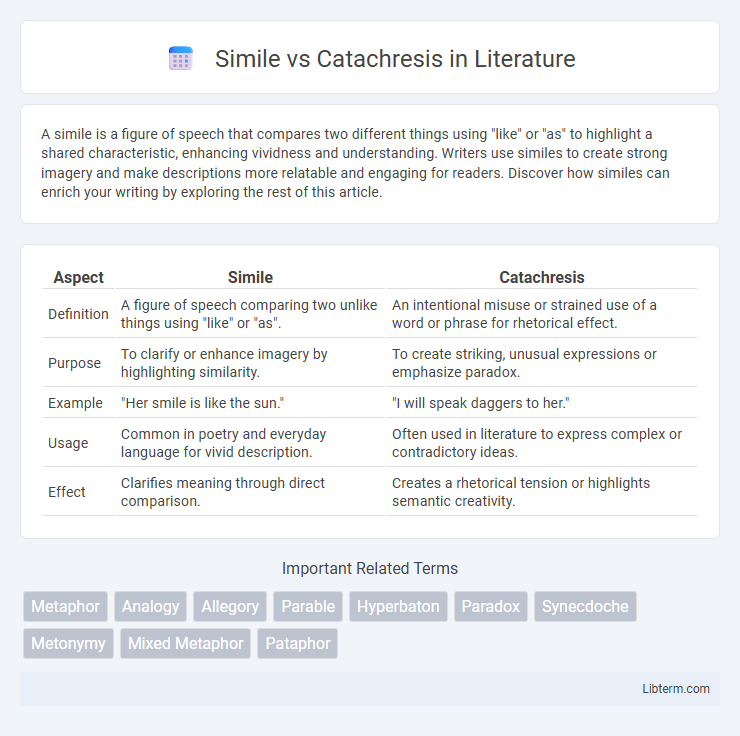A simile is a figure of speech that compares two different things using "like" or "as" to highlight a shared characteristic, enhancing vividness and understanding. Writers use similes to create strong imagery and make descriptions more relatable and engaging for readers. Discover how similes can enrich your writing by exploring the rest of this article.
Table of Comparison
| Aspect | Simile | Catachresis |
|---|---|---|
| Definition | A figure of speech comparing two unlike things using "like" or "as". | An intentional misuse or strained use of a word or phrase for rhetorical effect. |
| Purpose | To clarify or enhance imagery by highlighting similarity. | To create striking, unusual expressions or emphasize paradox. |
| Example | "Her smile is like the sun." | "I will speak daggers to her." |
| Usage | Common in poetry and everyday language for vivid description. | Often used in literature to express complex or contradictory ideas. |
| Effect | Clarifies meaning through direct comparison. | Creates a rhetorical tension or highlights semantic creativity. |
Understanding Figures of Speech: Simile and Catachresis
Similes explicitly compare two different things using "like" or "as," creating clear and vivid imagery, such as "as brave as a lion." Catachresis, meanwhile, involves the deliberate misuse or strained use of a word or phrase for rhetorical effect, often blending metaphors in unconventional ways, like "the voice of your eyes." Mastery of simile and catachresis enhances literary expression by balancing clarity and creative distortion within figures of speech.
Defining Simile: A Tool for Comparison
Simile is a figure of speech that directly compares two different things using connecting words such as "like" or "as," enhancing descriptive clarity and vivid imagery. It serves as an essential rhetorical device in literature and everyday language by highlighting similarities between disparate objects or concepts, making abstract ideas more relatable. Unlike catachresis, which involves the deliberate misuse of words for rhetorical effect, similes rely on clear, explicit comparisons to convey meaning.
What is Catachresis? Beyond Literal Meaning
Catachresis is a rhetorical device that involves the intentional misuse or strained use of words to create a striking, often paradoxical, expression beyond their literal meaning. Unlike a simile, which explicitly compares two different things using "like" or "as," catachresis combines metaphors in an unconventional way to convey complex or abstract ideas. This deliberate linguistic distortion challenges conventional meaning, enriching language by evoking vivid imagery or highlighting conceptual nuances.
Key Differences Between Simile and Catachresis
Simile explicitly compares two different things using words like "like" or "as" to highlight similarities, while catachresis involves the improper or strained use of words or mixed metaphors to create a rhetorical effect. Similes are clear and intentional figures of speech commonly used for clarity or vivid description, whereas catachresis conveys meaning through deliberate misuse or unconventional application, often generating confusion or emphasis. The key difference lies in simile's direct comparison versus catachresis's creative linguistic distortion.
The Role of Imagery in Simile and Catachresis
Simile employs vivid imagery by directly comparing two unlike things using "like" or "as," creating clear and relatable visual pictures that enhance understanding and emotional impact. Catachresis, however, involves an intentional misuse or strained use of imagery, producing unconventional or paradoxical expressions that challenge perception and evoke complex interpretations. Both devices manipulate imagery but differ in clarity and purpose--simile clarifies through comparison, while catachresis disrupts expectations to provoke thought.
Common Uses of Simile in Literature
Similes commonly appear in literature to create vivid imagery and clarify complex emotions by comparing two unlike things using "like" or "as." They enhance readers' understanding and engagement by making descriptions more relatable, such as comparing a character's bravery to a lion's courage. Unlike catachresis, which often involves strained or mixed metaphors for emphasis or stylistic effect, similes maintain clear and accessible comparisons.
Catachresis in Poetry and Prose
Catachresis in poetry and prose serves as a powerful rhetorical device that intentionally misuses language to create striking imagery or express complex ideas beyond literal meanings. Unlike similes, which draw explicit comparisons using "like" or "as," catachresis often blends contradictory metaphors or introduces novel expressions to challenge conventional language and evoke emotional or intellectual responses. This deliberate linguistic distortion enriches literary texts by encouraging readers to engage with ambiguity and layered interpretations.
Famous Examples: Simile vs. Catachresis
Famous examples of simile include Shakespeare's "like a summer's day" in Sonnet 18, illustrating vivid comparisons using "like" or "as" to enhance imagery. In contrast, catachresis is exemplified by expressions like "mouth of the cave" or Emily Dickinson's "the little heels run on the grass," where metaphoric misuse or strained figurative language creates striking, unconventional imagery. These devices serve distinct rhetorical purposes: similes clarify by likening, while catachresis provokes thought through deliberate semantic tension.
Impact on Reader Perception and Interpretation
Similes create clear, relatable comparisons that enhance reader understanding by linking unfamiliar concepts to familiar images, fostering vivid visualization and emotional resonance. Catachresis, through its deliberate misuse or strained metaphor, challenges conventional language, provoking readers to rethink meanings and engage with text on a more abstract or complex level. The impact of similes is generally clarifying and comforting, while catachresis disrupts expectations, encouraging deeper interpretation and critical analysis.
Choosing Between Simile and Catachresis in Writing
Choosing between simile and catachresis in writing depends on the desired effect of clarity versus creative exaggeration. Similes create vivid, relatable comparisons using "like" or "as," enhancing reader understanding through familiar imagery. Catachresis deliberately bends or combines metaphors to produce striking, unconventional expressions that challenge conventional meaning and evoke strong emotional responses.
Simile Infographic

 libterm.com
libterm.com